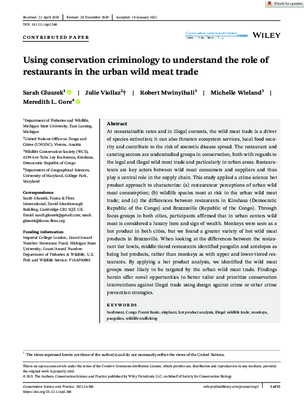Using conservation criminology to understand the role of restaurants in the urban wild meat trade
At unsustainable rates and in illegal contexts, the wild meat trade is a driver of species extinction; it can also threaten ecosystem services, local food security and contribute to the risk of zoonotic disease spread. The restaurant and catering sectors are understudied groups in conservation, both with regards to the legal and illegal wild meat trade and particularly in urban areas. Restaurateurs are key actors between wild meat consumers and suppliers and thus play a central role in the supply chain. This study applied a crime science hot product approach to characterize: (a) restaurateur perceptions of urban wild meat consumption; (b) wildlife species most at risk in the urban wild meat trade; and (c) the differences between restaurants in Kinshasa (Democratic Republic of the Congo) and Brazzaville (Republic of the Congo). Through focus groups in both cities, participants affirmed that in urban centers wild meat is considered a luxury item and sign of wealth. Monkeys were seen as a hot product in both cities, but we found a greater variety of hot wild meat products in Brazzaville. When looking at the differences between the restaurant tier levels, middle-tiered restaurants identified pangolin and antelopes as being hot products, rather than monkeys as with upper and lower-tiered restaurants. By applying a hot product analysis, we identified the wild meat groups most likely to be targeted by the urban wild meat trade. Findings herein offer novel opportunities to better tailor and prioritize conservation interventions against illegal trade using design against crime or other crime prevention strategies.
https://biodiversitylinks.org/learning-evidence/wild-meat-collaborative-learning-group/evidence-collection/evidence-inbox/using-conservation-criminology_wild-meat.pdf/view
https://biodiversitylinks.org/learning-evidence/wild-meat-collaborative-learning-group/evidence-collection/evidence-inbox/using-conservation-criminology_wild-meat.pdf/@@download/image/image.png
File
Using conservation criminology to understand the role of restaurants in the urban wild meat trade
Author(s):
Gluszek, Sarah
,
Viollaz, Julie
,
Mwinyihali, Robert
,
Wieland, Michelle
,
Gore, Meredith L.
Publication Date: 2021
Location: Africa
DOWNLOAD FILE
At unsustainable rates and in illegal contexts, the wild meat trade is a driver of species extinction; it can also threaten ecosystem services, local food security and contribute to the risk of zoonotic disease spread. The restaurant and catering sectors are understudied groups in conservation, both with regards to the legal and illegal wild meat trade and particularly in urban areas. Restaurateurs are key actors between wild meat consumers and suppliers and thus play a central role in the supply chain. This study applied a crime science hot product approach to characterize: (a) restaurateur perceptions of urban wild meat consumption; (b) wildlife species most at risk in the urban wild meat trade; and (c) the differences between restaurants in Kinshasa (Democratic Republic of the Congo) and Brazzaville (Republic of the Congo). Through focus groups in both cities, participants affirmed that in urban centers wild meat is considered a luxury item and sign of wealth. Monkeys were seen as a hot product in both cities, but we found a greater variety of hot wild meat products in Brazzaville. When looking at the differences between the restaurant tier levels, middle-tiered restaurants identified pangolin and antelopes as being hot products, rather than monkeys as with upper and lower-tiered restaurants. By applying a hot product analysis, we identified the wild meat groups most likely to be targeted by the urban wild meat trade. Findings herein offer novel opportunities to better tailor and prioritize conservation interventions against illegal trade using design against crime or other crime prevention strategies.


